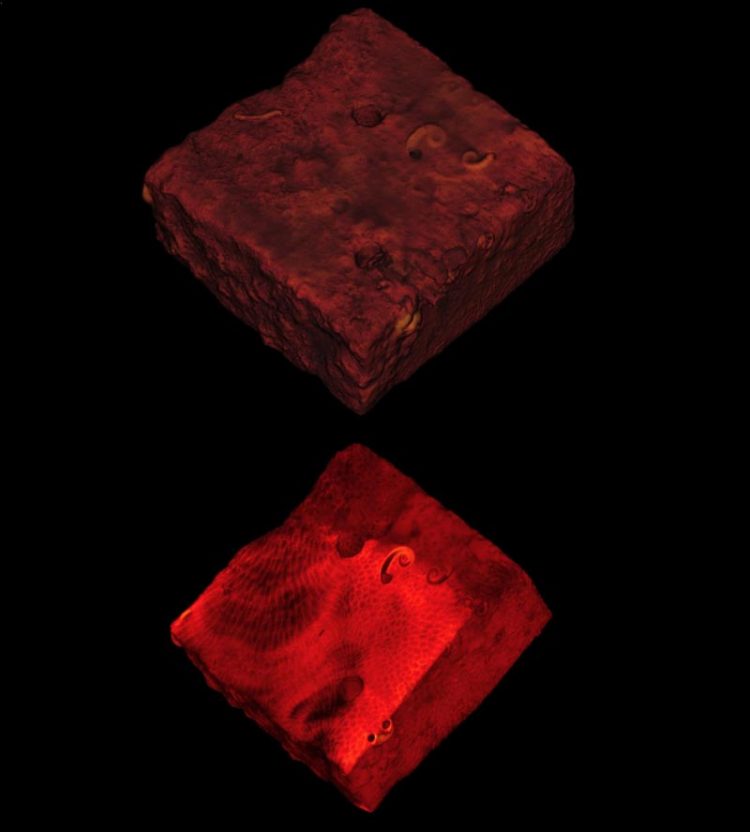CT scans of coral skeletons reveal ocean acidity increases reef erosion

This is an image of µCT scan showing the outside (top) and inside (bottom) of an experimental coral block after a one-year deployment in Kāne'ohe Bay, Hawai'i. Note the bioerosion scars inside the block. Credit: Nyssa Silbiger at UH Mānoa and Mark Riccio at the Cornell Unversity µCT Facility for Imaging and Preclinical Research
Simultaneously, bioeroders, such as parrotfish and boring marine worms, breakdown the reef structure into rubble and the sand that nourishes our beaches. For reefs to persist, rates of reef construction must exceed reef breakdown.
This balance is threatened by increasing atmospheric carbon dioxide, which causes ocean acidification (decreasing ocean pH). Prior research has largely focused on the negative impacts of ocean acidification on reef growth, but new research this week from scientists at the Hawai'i Institute of Marine Biology (HIMB), based at the University of Hawai'i – Mānoa (UHM), demonstrates that lower ocean pH also enhances reef breakdown: a double-whammy for coral reefs in a changing climate.
To measure bioerosion, researchers deployed small blocks of calcium carbonate (dead coral skeleton) onto the reef for one year. Traditionally, these blocks are weighed before and after deployment on the reef; however, HIMB scientists used microCT (a high-resolution CT scan) to create before and after 3-D images of each block. According to Nyssa Silbiger, lead author of the study and doctoral candidate at HIMB, this novel technique provides a more accurate measurement of accretion and erosion rates.
The researchers placed the bioerosion blocks along a 100-ft transect on shallow coral reef in Kāne'ohe Bay, Hawai'i, taking advantage of natural variability of pH in coastal reefs. The study compared the influence of pH, resource availability, temperature, distance from shore, and depth on accretion-erosion balance. Among all measured variables, pH was the strongest predictor of accretion-erosion. Reefs shifted towards higher rates of erosion in more acidic water – a condition that will become increasingly common over the next century of climate change.
This study also highlights the impact of fine-scale variation in coastal ocean chemistry on coral reefs. Current models from the International Panel on Climate Change (IPCC) predict changes in pH for the open ocean, but these predictions are problematic for coral reefs, which are embedded in highly variable coastal ecosystems. The study found dramatic differences in ocean pH and in the daily variability of pH across a short distance.
“It was surprising to discover that small-scale changes in the environment can influence ecosystem-level reef processes,” said Silbiger. “We saw changes in pH on the order of meters and those small pH changes drove the patterns in reef accretion-erosion.”
Silbiger and colleagues are learning all they can from the microCT scans, as this is the first time before-and-after microCT scans were used as a measure of accretion-erosion on coral reefs. In ongoing work, they are using this technology to distinguish between accretion and erosion and to single out erosion scars from specific bioeroder groups (e.g., holes from boring worms versus bioeroding sponges). The researchers are also using this technology to investigate the drivers of the accretion-erosion balance over the much larger area of the Hawaiian Archipelago.
NJ Silbiger, O Guadoyal, FIM Thomas, MJ Donahue (2014) Reefs shift from net accretion to net erosion along a natural environmental gradient. Marine Ecology Progress Series, vol. 515, doi: 10.3354/meps10999
The School of Ocean and Earth Science and Technology at the University of Hawaii at Manoa was established by the Board of Regents of the University of Hawai'i in 1988 in recognition of the need to realign and further strengthen the excellent education and research resources available within the University. SOEST brings together four academic departments, three research institutes, several federal cooperative programs, and support facilities of the highest quality in the nation to meet challenges in the ocean, earth and planetary sciences and technologies.
Media Contact
More Information:
http://www.hawaii.eduAll latest news from the category: Ecology, The Environment and Conservation
This complex theme deals primarily with interactions between organisms and the environmental factors that impact them, but to a greater extent between individual inanimate environmental factors.
innovations-report offers informative reports and articles on topics such as climate protection, landscape conservation, ecological systems, wildlife and nature parks and ecosystem efficiency and balance.
Newest articles

Nerve cells of blind mice retain their visual function
Nerve cells in the retina were analysed at TU Wien (Vienna) using microelectrodes. They show astonishingly stable behavior – good news for retina implants. The retina is often referred to…

State-wide center for quantum science
Karlsruhe Institute of Technology joins IQST as a new partner. The mission of IQST is to further our understanding of nature and develop innovative technologies based on quantum science by…

Newly designed nanomaterial
…shows promise as antimicrobial agent. Rice scientists develop nanocrystals that kill bacteria under visible light. Newly developed halide perovskite nanocrystals (HPNCs) show potential as antimicrobial agents that are stable, effective…



